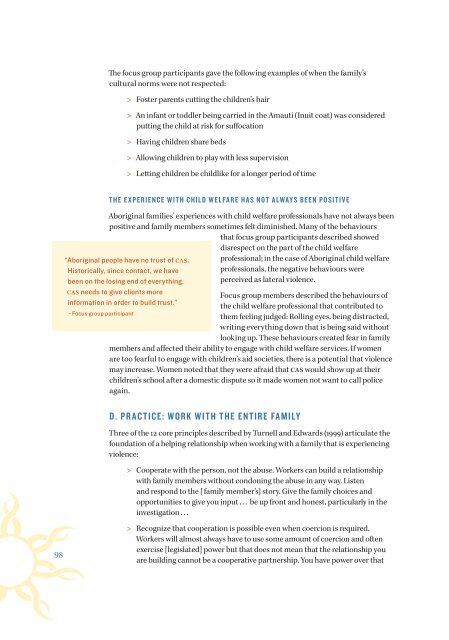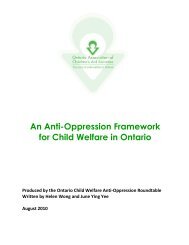English - Ontario Association of Children's Aid Societies
English - Ontario Association of Children's Aid Societies
English - Ontario Association of Children's Aid Societies
You also want an ePaper? Increase the reach of your titles
YUMPU automatically turns print PDFs into web optimized ePapers that Google loves.
The focus group participants gave the following examples <strong>of</strong> when the family’s<br />
cultural norms were not respected:<br />
> > Foster parents cutting the children’s hair<br />
> > An infant or toddler being carried in the Amauti (Inuit coat) was considered<br />
putting the child at risk for suffocation<br />
> > Having children share beds<br />
> > Allowing children to play with less supervision<br />
> > Letting children be childlike for a longer period <strong>of</strong> time<br />
THE EXPERIENCE WITH CHILD WELFARE HAS NOT ALWAYS BEEN POSITIVE<br />
Aboriginal families’ experiences with child welfare pr<strong>of</strong>essionals have not always been<br />
positive and family members sometimes felt diminished. Many <strong>of</strong> the behaviours<br />
that focus group participants described showed<br />
disrespect on the part <strong>of</strong> the child welfare<br />
“Aboriginal people have no trust <strong>of</strong> CAS.<br />
Historically, since contact, we have<br />
been on the losing end <strong>of</strong> everything.<br />
CAS needs to give clients more<br />
information in order to build trust.”<br />
- Focus group participant<br />
pr<strong>of</strong>essional; in the case <strong>of</strong> Aboriginal child welfare<br />
pr<strong>of</strong>essionals, the negative behaviours were<br />
perceived as lateral violence.<br />
Focus group members described the behaviours <strong>of</strong><br />
the child welfare pr<strong>of</strong>essional that contributed to<br />
them feeling judged: Rolling eyes, being distracted,<br />
writing everything down that is being said without<br />
looking up. These behaviours created fear in family<br />
members and affected their ability to engage with child welfare services. If women<br />
are too fearful to engage with children’s aid societies, there is a potential that violence<br />
may increase. Women noted that they were afraid that CAS would show up at their<br />
children’s school after a domestic dispute so it made women not want to call police<br />
again.<br />
98<br />
D. PRACTICE: WORK WITH THE ENTIRE FAMILY<br />
Three <strong>of</strong> the 12 core principles described by Turnell and Edwards (1999) articulate the<br />
foundation <strong>of</strong> a helping relationship when working with a family that is experiencing<br />
violence:<br />
> > Cooperate with the person, not the abuse. Workers can build a relationship<br />
with family members without condoning the abuse in any way. Listen<br />
and respond to the [ family member’s] story. Give the family choices and<br />
opportunities to give you input . . . be up front and honest, particularly in the<br />
investigation . . . <br />
> > Recognize that cooperation is possible even when coercion is required.<br />
Workers will almost always have to use some amount <strong>of</strong> coercion and <strong>of</strong>ten<br />
exercise [legislated] power but that does not mean that the relationship you<br />
are building cannot be a cooperative partnership. You have power over that

















